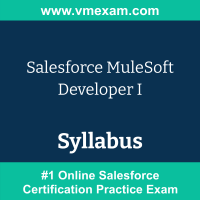 The Salesforce MuleSoft Developer I exam preparation guide is designed to provide candidates with necessary information about the MuleSoft Developer I exam. It includes exam summary, sample questions, practice test, objectives and ways to interpret the exam objectives to enable candidates to assess the types of questions-answers that may be asked during the Salesforce Certified MuleSoft Developer I exam.
The Salesforce MuleSoft Developer I exam preparation guide is designed to provide candidates with necessary information about the MuleSoft Developer I exam. It includes exam summary, sample questions, practice test, objectives and ways to interpret the exam objectives to enable candidates to assess the types of questions-answers that may be asked during the Salesforce Certified MuleSoft Developer I exam.
It is recommended for all the candidates to refer the MuleSoft Developer I objectives and sample questions provided in this preparation guide. The Salesforce MuleSoft Developer I certification is mainly targeted to the candidates who want to build their career in Salesforce Developer domain and demonstrate their expertise. We suggest you to use practice exam listed in this cert guide to get used to with exam environment and identify the knowledge areas where you need more work prior to taking the actual Salesforce MuleSoft Developer I exam.
Salesforce MuleSoft Developer I Exam Summary:
|
Exam Name
|
Salesforce MuleSoft Developer I |
| Exam Code | MuleSoft Developer I |
| Exam Price |
Registration fee: USD 200 Retake fee: USD 100 |
| Duration | 120 minutes |
| Number of Questions | 60 |
| Passing Score | 70% |
| Recommended Training / Books |
Anypoint Platform Development: Fundamentals (DEX401) Anypoint Platform Development: Fundamentals (DEX401) Getting Started with Anypoint Platform (MAX150) |
| Schedule Exam | Kryterion Webassessor |
| Sample Questions | Salesforce MuleSoft Developer I Sample Questions |
| Recommended Practice | Salesforce Certified MuleSoft Developer I Practice Test |
Salesforce MuleSoft Developer I Syllabus:
| Section | Objectives | Weight |
|---|---|---|
| Creating Application Networks |
- Identify core architectural concepts of the Application Network and modern APIs. - Identify features of an API-led approach. - Identify features of MuleSoft's recommended Operational Model (C4E). - Apply correct processors/syntax and predict outcomes to consume RESTful web services (RAML-based). |
7% |
| Designing APIs |
- Use REST API methods and resources. - Define REST API parameters and responses. - Call RESTful services defined by RAML syntax. |
8% |
| Accessing and modifying Mule events |
- Apply correct processors/DataWeave expressions to access and modify Mule event payloads, and predict outcomes. - Apply correct processors/DataWeave expressions to access and modify Mule event attributes, and predict outcomes. - Apply correct processors/DataWeave expressions to access and modify Mule variables, and predict outcomes. - Apply correct processors/DataWeave expressions to enrich Mule events using Mule 4 connector targets, and predict outcomes. |
10% |
| Structuring Mule applications |
- Specify when and how to structure Mule applications into separate configuration and properties files, and predict outcomes. - Specify when and how to pass events between flows and subflows using connectors and flow references, and predict outcomes. |
10% |
| Building API implementation interfaces |
- Manually build API implementations from an API specification, RAML or not. - Predict the results of APIkit based upon a RAML specification. - Implement correct responses based on a RAML specification, either manually or with APIkit. |
7% |
| Using Connectors |
- Apply correct processors/syntax to connect to databases, and predict outcomes. - Apply correct processors/syntax to connect to files or FTP servers, and predict outcomes. - Apply correct processors/syntax to retrieve and combine data in the middle of a flow, and predict outcomes. |
10% |
| Processing records |
- Apply correct processors/syntax to process individual records in a collection using For Each scopes, and predict outcomes. - Apply correct processors/syntax to process individual records in a collection using batch scopes, and predict outcomes. - Apply correct processors/syntax to process individual records in a collection using async scopes, and predict outcomes. - Apply correct processors/syntax to process individual records in a collection using DB listeners, and predict outcomes. - Apply correct processors/syntax to process individual records in a collection using messaging queues, and predict outcomes. - Apply correct processors/syntax to persist data between flow executions. |
10% |
| Transforming data |
- Convert between output types and data types using DataWeave. - Predict the result of core DataWeave functions. - Apply correct syntax to write DataWeave transformations to coerce, format, order, and filter data, and predict outcomes. - Call Mule flows from a DataWeave script. - Define, use, and reuse DataWeave modules, functions, and variables, and predict outcomes. |
10% |
| Routing events |
- Apply correct processors/syntax to route messages using DataWeave conditions within a choice router, and predict outcomes. - Apply correct processors/syntax to scatter and gather messages, and predict outcomes. - Apply correct processors/syntax to validate Mule events, and predict outcomes. |
8% |
| Handling errors |
- Apply correct processors/syntax to implement global error handlers, and predict outcomes. - Apply correct processors/syntax to implement on-error continue and on-error propagate handlers, and predict outcomes. - Apply correct processors/syntax to combine multiple error handlers, and predict outcomes. - Apply correct processors /syntax to implement try scopes, and predict outcomes. - Apply correct processors/syntax to map custom errors, and predict outcomes. |
8% |
| Debugging and troubleshooting Mule applications |
- Apply correct MUnit processors to implement basic automatic tests for Mule applications, and predict outcomes. - Identify root causes for errors when debugging Mule applications, and predict outcomes. |
5% |
| Deploying and managing APIs and integrations |
- Deploy applications to CloudHub. - Manage APIs using separate proxies and auto-discovery. - Manage API policies. |
7% |
